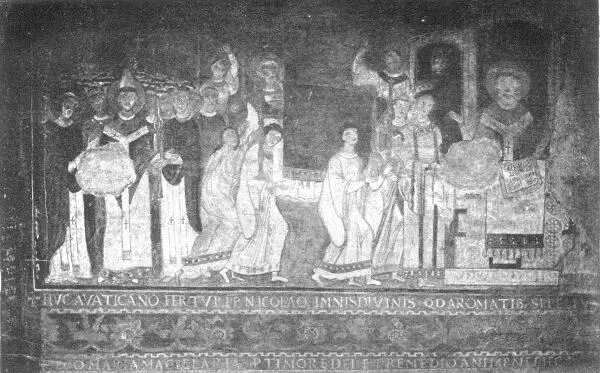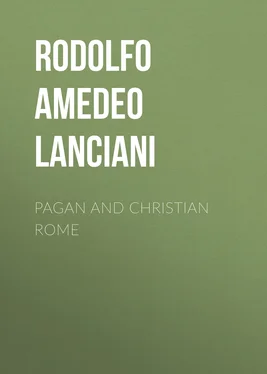Rodolfo Amedeo Lanciani - Pagan and Christian Rome
Здесь есть возможность читать онлайн «Rodolfo Amedeo Lanciani - Pagan and Christian Rome» — ознакомительный отрывок электронной книги совершенно бесплатно, а после прочтения отрывка купить полную версию. В некоторых случаях можно слушать аудио, скачать через торрент в формате fb2 и присутствует краткое содержание. Жанр: foreign_edu, История, История, на английском языке. Описание произведения, (предисловие) а так же отзывы посетителей доступны на портале библиотеки ЛибКат.
- Название:Pagan and Christian Rome
- Автор:
- Жанр:
- Год:неизвестен
- ISBN:нет данных
- Рейтинг книги:3 / 5. Голосов: 1
-
Избранное:Добавить в избранное
- Отзывы:
-
Ваша оценка:
- 60
- 1
- 2
- 3
- 4
- 5
Pagan and Christian Rome: краткое содержание, описание и аннотация
Предлагаем к чтению аннотацию, описание, краткое содержание или предисловие (зависит от того, что написал сам автор книги «Pagan and Christian Rome»). Если вы не нашли необходимую информацию о книге — напишите в комментариях, мы постараемся отыскать её.
Pagan and Christian Rome — читать онлайн ознакомительный отрывок
Ниже представлен текст книги, разбитый по страницам. Система сохранения места последней прочитанной страницы, позволяет с удобством читать онлайн бесплатно книгу «Pagan and Christian Rome», без необходимости каждый раз заново искать на чём Вы остановились. Поставьте закладку, и сможете в любой момент перейти на страницу, на которой закончили чтение.
Интервал:
Закладка:
The Templum Sacræ Urbis (SS. Cosma e Damiano).
In the third chapter I shall have occasion to describe the transformation of nearly all the great public buildings of imperial Rome into places of Christian worship, but it falls within the scope of this chapter to remark that, in many instances, the pagan decorations of those buildings were not affected by the change. When Felix IV. took possession of the templum sacræ urbis , and dedicated it to SS. Cosma and Damianus, the walls of the building were covered with incrustations of the time of Septimius Severus representing the wolf and other profane emblems. Pope Felix not only accepted them as an ornament to his church, but tried to copy them in the apse which he rebuilt. The same process was followed by Pope Simplicius (a. d. 468-483), in transforming the basilica of Junius Bassus on the Esquiline into the church of S. Andrea. 19 19 In the Byzantine period this church and the adjoining monastery were called casa Barbara patricia . They are now comprised within the cloisters of S. Antonio all' Esquilino, on the left side of S. Maria Maggiore.
The faithful, raising their eyes towards the tribune, could see the figures of Christ and his apostles in mosaic; turning to the side walls, they could see Nero, Galba, and six other Roman emperors, Diana hunting the stag, Hylas stolen by the nymphs, Cybele on the chariot drawn by lions, a lion attacking a centaur, the chariot of Apollo, figures performing mysterious Egyptian rites, and other such profanities, represented in opus sectile marmoreum , a sort of Florentine mosaic. This unique set of intarsios was destroyed in the sixteenth century by the French Antonian monks for a reason worth relating. They believed that the glutinous substance by which the layer of marble or mother-of-pearl was kept fast was an excellent remedy against the ague; hence every time one of them was attacked by fever, a portion of those marvellous works was sacrificed. Fever must have raged quite fiercely among the French monks, because when this wanton practice was stopped, only four pictures were left. Two are now preserved in the church of S. Antonio, in the chapel of the saint; two in the Palazzo Albani del Drago alle Quattro Fontane, on the landing of the stairs. 20 20 These incrustations, and the basilica to which they belong, have been illustrated by Ciampini: Vetera monumenta , vol. i. plates xxii.-xxiv.—D'Agincourt: Histoire de l'art, Peinture , pl. xiii. 3.—Minutoli: Ueber die Anfertigung und die Nutzanwendung der färbigen Gläser bei den Alten , pl. iv.—De Rossi: La basilica di Giunio Basso , in the Bullettino di archeologia cristiana , 1871, p. 46.
Mosaic from the church of S. Andrea.
Intarsios of the same kind have been seen and described in the basilica of S. Croce in Gerusalemme, in the church of S. Stefano Rotondo, in that of S. Adriano, etc. When the offices adjoining the Senate Hall were transformed into the church of S. Martina, the side walls were adorned with the bas-reliefs of the triumphal arch of M. Aurelius, now in the Palazzo dei Conservatori (first landing, nos. 42, 43, 44). One of them, representing the emperor sacrificing before the Temple of Jupiter, is given opposite page 90.
The decoration of the churches, like that of the temples, was mostly done by private contributions and gifts of works of art. The laying out of the pavement, for instance, or the painting of the walls was apportioned to voluntary subscribers, each of whom was entitled to inscribe his name on his section of the work. The pavement of the lower basilica of Parenzo, in Dalmatia, is divided into mosaic panels of various sizes, representing vases, wreaths, fish, and animals; and to each panel is appended the name of the contributor:—
"Lupicinus and Pascasia made one hundred [square] feet.
"Clamosus and Successa, one hundred feet.
"Felicissimus and his relatives, one hundred feet.
"Fausta, the patrician, and her relatives, sixty feet.
"Claudia, devout woman, and her niece Honoria, made one hundred and ten feet, in fulfilment of a vow." 21
Theseus killing the Minotaur in the labyrinth of Crete, and labyrinths in general, were favorite subjects for church pavements, especially among the Gauls. The custom is very ancient, a labyrinth having been represented in the church of S. Vitale at Ravenna as early as the sixth century. Those of the cathedral at Lucca, of S. Michele Maggiore at Pavia, of S. Savino at Piacenza, of S. Maria in Trastevere at Rome (destroyed in the restoration of 1867), are of a later date. The image of Theseus is accompanied by a legend in the "leonine" rhythm:—
The symbolism of the subject is explained thus: The labyrinth, so easy of access, but from which no one can escape, is symbolical of human life. At the time of the Crusades, church labyrinths began to be used for a practical purpose. The faithful were wont to go over the meandering paths on their knees, murmuring prayers in memory of the passion of the Lord. Under the influence of this practice the classic and Carolingian name—labyrinth—was forgotten; and the new one of rues de Jerusalem , or leagues , adopted. The rues de Jerusalem in the cathedral at Chartres, designed in blue marble, were 666 feet long; and it took an hour to finish the pilgrimage. Later the labyrinths lost their religious meaning, and became a pastime for idlers and children. The one in the church at Saint-Omer has been destroyed, because the celebration of the office was often disturbed by irreverent visitors trying the sport. 22
In Rome we have several instances of these private artistic contributions in the service of churches. The pavement of S. Maria in Cosmedin is the joint offering of many parishioners; and so were those of S. Lorenzo fuori le Mura and S. Maria Maggiore before their modern restoration. The names of Beno de Rapiza, his wife Maria Macellaria, and his children Clement and Attilia are attached to the frescoes of the lower church of S. Clemente; and that of Beno alone to the paintings of S. Urbano alla Caffarella. In the apse of S. Sebastiano in Pallara, on the Palatine, and in that of S. Saba on the Aventine, we read the names of a Benedictus and of a Saba, at whose expense the apses were decorated.
We cannot help following with emotion the development of this artistic feeling even among the lowest classes of mediæval Rome. 23We read of an Ægidius, son of Hippolytus, a shoemaker of the Via Arenula, leaving his substance to the church of S. Maria de Porticù, with the request that it should be devoted to the building of a chapel, "handsome and handsomely painted, so that everybody should take delight in looking at it." Such feelings, exceptional in many Italian provinces, were common throughout Tuscany. When the triptych of Duccio Buoninsegna, now in the "Casa dell' opera" at Siena, was carried from his studio to the Duomo, June 9, 1310, the whole population followed in a triumphant procession. Renzo di Maitano, another Sienese artist of fame, had the soul of a poet. He was the first to advocate the erection of a church, "grand, beautiful, magnificent, whose just proportions in height, breadth, and length should so harmonize with the details of the decoration as to make it decorous and solemn, and worthy of the worship of Christ in hymns and canticles, for the protection and glory of the city of Siena." So spoke the artists of that age, and their language was understood and felt by the multitudes. Their lives were made bright and cheerful in spite of the troubles and misfortunes which weighed upon their countries. Think of such sentiments in our age!

THE TRANSLATION OF S. CYRIL'S REMAINS
Читать дальшеИнтервал:
Закладка:
Похожие книги на «Pagan and Christian Rome»
Представляем Вашему вниманию похожие книги на «Pagan and Christian Rome» списком для выбора. Мы отобрали схожую по названию и смыслу литературу в надежде предоставить читателям больше вариантов отыскать новые, интересные, ещё непрочитанные произведения.
Обсуждение, отзывы о книге «Pagan and Christian Rome» и просто собственные мнения читателей. Оставьте ваши комментарии, напишите, что Вы думаете о произведении, его смысле или главных героях. Укажите что конкретно понравилось, а что нет, и почему Вы так считаете.












